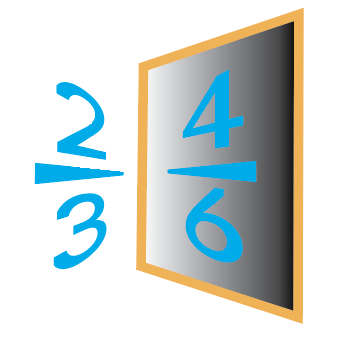
Why are the ones times tables easiest to learn?
Well, one group of a billion is a billion. A line of tiles 250 long and only one tile high will have 250 tiles in it. When you skip count by one, there aren’t any numbers left out ~ there isn’t anything to skip over. Multiplying any number by one will not change the identity of the number.
Multiplying a Number by One Doesn’t Change the Number
Children need time and experience playing around with this idea in order to understand how it works. It is important for young students to be able to explain why multiplying by one doesn’t change a number.
Neither does Dividing by One.
Whole numbers are counted in steps of one ~ it takes one step to get from zero to one ~ any number is just a tally of how many single steps away from zero it is on the number line. How is this related to why whole numbers have a denominator of one?
When students move on to study fractions they will realize that the numerator represents the tally of unit fractions in the number, and the denominator shows the size of the step. Since whole numbers by definition are one single step apart from each other, they have a denominator of one. In the case of whole numbers, the numerator and the quotient (when viewing fractions as division) are the same number, written with the same digits. This shows that dividing by one doesn’t change a number.
What Does “The Identity of the Number Doesn’t Change” Mean?
Young children will not ask this question. To them the same number, means the same number. This question seems silly ~ until they start thinking like a mathematician. From a mathematician’s point of view ~
Numbers are the same when they ~
- Can be substituted for one another ~ 4/6 can replace 2/3 in a number sentence.
- Share a place on the number line.
- Have the same area, length, weight, value, height, volume, duration, or other key measurement.
- Reduce to the same simplest form ~ one-half and two-fourths are the same number.
Like so many concepts in math, students must continue to expand their understanding of the idea as they learn more advanced topics. The Multiplicative Identity of One may seem self evident to little kids just learning to multiply or divide, but it will take on new importance when those students learn about rational numbers.
Lower elementary teachers plant the seed and upper elementary teachers help it grow.
Multiplying by one does not change a number. Dividing by one doesn’t change a number. The number stays in the same place on the number line in either case. This works when multiplying/dividing by one or by fractions equivalent to one. Students must understand this property before they can make sense of equivalent fractions.
Share This Story, Choose Your Platform!
Download Colorful Collections:
A Mindful Exploration of Proper Fractions
Help your students make sense of fractions.
I started teaching in 1987, which means I’ve collected many tips and tricks along the way. In this ebook, I share concepts, strategies, and classroom materials to help you make math sticky.
Along with this useful ebook, you will receive weekly emails from StickyMath@UnCommon-Core.com. I send information like: teacher tips, educational ideas, book reviews, curated lists, reviews of educational sites, and free first drafts of products that I’m creating for my TPT store. That way, you get helpful ideas and free stuff, while I get some feedback before I finalize products and put them up for sale.
I value your privacy. I will never sell your information. You may unsubscribe at any time.
All the best!
Isabelle
Isabelle Hoag M. Ed.

